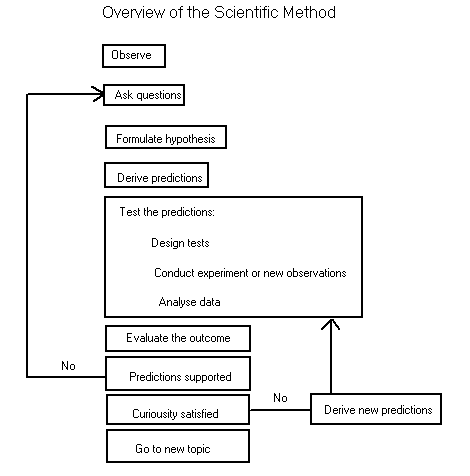The Scientific Method: An Overview
Key Ideas
- Observation and description: in other words, an empirical way of assessing phenomena in the universe.
- Formulation of a hypothesis that allows for predictability about the phenomena, and therefore, repeatability of the observation in question.
- Experiments that seek to show if the hypothesis will stand.
- Controls that are necessary to eliminate other factors that would influence the outcome of experiments .
- Falsiability: one should be able to show that the idea is actually false, therefore, the ability to disprove alternative explanations for the phenomena.
- Data evaluation determines whether the experiment is convincing or needs further elaboration and study.
- Models and theories: With repeated verification and expanding explanatory power, a hypothesis may be adapted as a working model and then as a widely accepted scientific theory.
- Demarcation: the hypothesis and experiments to gain a hearing must be accepted by the larger community of scientists as qualifying as scientific in nature (see more below).

Potential Oversights in the Basic Model
The above model, some would argue, ignores key elements in the way scientists actually practice science. In particular, it seems to imply that hypotheses and experiments simply suggest themselves as due course from the inductive natural phenomena. This overlooks some of the following:
- "Theory Laden" Factors: Formulating a new hypothesis is often dependent upon revisiting an old theory, revising a current one, or adopting a reigning meta-model (paradigm) as a guide for further speculation and questioning. Sometimes reigning models resist falsification because of their wide acceptance.
- Retroduction: Also a theory-laden activity, retroduction involves formulating a hypothesis to account for current known observations and ideas.
- Socio-Cultural & Psychological Factors: These include the values of cooperation, competition, information sharing, assumed ethics of research, departmental politics, etcetera that are part of the social world of scientific research, as well as psychological factors such as favored thought patterns, personal approaches, prejudices, aesthetics, vices, and so on.
- Scientific Intuition: Michel Polanyi observed that much scientific research is more intuitive in nature than is often admitted, and it is often passed along in non-verbalized ways:
1) conviviality: involves communication of true knowledge on the inarticulate level. Such knowledge involves a fair level of trust between teacher and student, and is therefore, essentially a-critical in nature.
2) tacit knowing: "true knowledge involves personal involvement in knowing, the link between knowing and responsibility. At the bottom of all human activity are things that are known, but cannot be put into words."
3) focal and subsidiary knowledge: "an awareness from and awareness to." Focal knowledge represents the activity that we focus on; subsidiary knowledge represents the latent knowledge that we must have to perform the task, i.e. bike racing requires a great deal of subsidiary knowledge that the racer cannot focus on in the midst of a race but must nonetheless have ingrained.
Factors in Demarcation
I. Factors involving the shape of the hypothesis:
- Simplicity or Parsimony (Occam's Razor): The hypothesis makes as few assumptions as possible, eliminating those that make no difference in the observable predictions of the explanatory model.
- Qualified: It must not claim too much.
- Consistency: Its parts must be coherent and compatible.
II. Factors involving provability:
- Contingency: It must allow for phenomena that need not happen within the hypothesis.
- Defeasibility: It must be capable of being shown as invalid.
- Corrigibility: It is open to future disconfirmation.
- Falsifiable: It must define the conditions under what it can be declared invalid by showing what the hypothesis will not allow.
- Testable: Counter-examples can be given and disproved.
III. Factors involving pertainability:
- Pertinent: It describes and explains observed phenomena.
- Correspondence: Its elements must reflect observable phenomena.
- Feasibility: One can actually conduct the experiments.
- Reproducible: It makes predictions that can be tested by any observer, with trials extending indefinitely into the future.
IV. Factors involving explanatory power:
- Adaptable: It can correct itself as new developments happen.
- Clarification: It has the ability to clear up a number of questions.
- Subsumptive: Either it can become a premise within another theory or it can subsume current theories to itself.
Questions
- How much trust should one afford modern science and the modern scientific method?
- How effective is the basic model? Explain.
- How cogent are the critiques of the basic model? Explain.
- If you were to revise the basic model what would you do differently?
- What aspects of reality, ways of knowing, or sources of truth does the typical scientific model avoid?
